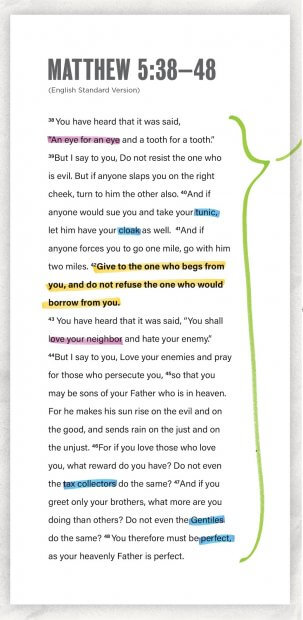Context is king, as they say. But when it comes to studying the Bible, context is far and wide.
A verse is contextualized in a passage; a passage in a biblical book; a biblical book in a particular place and time; and each time and place is characterized by language and culture.
Yet the biblical writings are not limited to the ancient world. “All Scripture is breathed out by God and profitable . . . for training in righteousness” (2 Tim 3:16). The Bible is both ancient and eternal. It is contextualized to then and applicable now.
When we neglect the context, it’s easy to end up studying the Bible as if it were Old MacDonald’s farm: here a verse, there a verse, everywhere a verse, verse. But as we pay attention to what surrounds a verse—in the text and in its cultural setting—we can get a clearer sense of what God is saying to us.
We recontextualize Scripture each time we read it. How can we honor Scripture’s context while applying it today? To answer this question, let’s look at a commonly cited statement from Jesus: “Give to the one who begs from you, and do not refuse the one who would borrow from you” (Matthew 5:42). How should we understand this verse today? Should I simply give to anyone who asks of me, or did Jesus mean something else entirely?
In four steps, we will analyze this verse and its surrounding context. The results will likely surprise you.
Step 1: Contextualize the verse within its passage
By looking at what comes before a verse and after it, we can identify the larger discourse and overall themes. Matthew 5:42 is couched between Jesus’ comments about two sayings his audience would have known well. A resource like Faithlife Study Bible (FSB) explains these sayings.

FSB notes that “An eye for eye” is a “principle, often referred to as lex talionis or the ‘law of retaliation’ (see Exod 21–24),” and that it “contrasts with the unexpected generosity that a member of the kingdom of heaven should display.”
FSB also explains that “You shall love your neighbor” is a quotation of Leviticus 19:18. But “hate your enemy” is not a direct Old Testament quotation; instead, it could be an allusion to a number of verses or “a colloquialism of the time.”
By taking a closer look at these statements (before and after v. 42), we can see the passage’s larger theme: Jesus is addressing how to treat someone who has wronged you, not what to do when someone asks you for money.
Pro Tip: Use a study Bible—especially its overview notes on a range of verses—to avoid Old MacDonald theology.
Step 2: Contextualize the passage in the book and in its original context
A Bible dictionary is a great place to learn basic information about a biblical book and its original context. Other good resources include study guides and commentaries written for a general audience.
Matthew 5:38–48 is part of the Sermon on the Mount (Matt 5–7), which according to Lexham Bible Dictionary is the first of “five large blocks” of Jesus’ teachings in Matthew. With this context in mind, N. T. Wright in Matthew for Everyone categorizes Matthew 5:38–48 under the heading “Loving your enemies.” Wright explains that Jesus is contrasting his views with first-century Israelite teaching:
Jesus offers a new sort of justice, a creative, healing, restorative justice. The old justice found in [parts of the Old Testament] was designed to prevent revenge running away with itself . . . [But Jesus] reflect[s] the astonishingly patient love of God himself.” (51)
Jesus’ disciples should reflect God’s self-sacrificial love; this is the intent of God’s law.
Pro Tip: Application-based commentaries often emphasize the “big picture” of a biblical book, which helps with contextualizing a passage. Supplement this with a Bible dictionary to see multiple options for outlining a biblical book.
Step 3: Look at key words and phrases, based on the original language and culture
The tools and resources in Logos Bible Software offer great help for understanding key terms. One resource in Logos is a set of handbooks created by the United Bible Society to provide guidance for cross-cultural Bible translators. These handbooks are filled with rich insights for personal study.
“Tunic” (or “coat”) and “cloak.” The United Bible Society Handbook on Matthew states, “The outer garment (cloak) was both an article of clothing and a covering for the night. Israelite law did not permit it to be kept from its owner overnight. . . . The coat was a long, close-fitting garment worn next to the skin. . . . Translators may prefer to say ‘your garment that is of little value’ and ‘your outer garment that is more valuable’” (149–50). Jesus is saying if anyone desires to wrong you, be generous in return.
“Tax collectors.” The UBS Handbook notes: “The Roman system for gathering taxes made for inequality and oppression, and that is one reason that in the Gospels tax collectors are quite often grouped together with sinners” (154–55). Society is often corrupt, so that’s not where the Christian finds his or her ethical code.
“Gentiles.” As the UBS Handbook explains, using the translation “‘those who do not know God’ for gentiles has often been a useful model” (156). In the Bible, the term “gentiles” does not refer to an ethnic or geographic group of people. It essentially means everyone who does not know the God of Israel.
“Perfect.” The UBS Handbook emphasizes that “Perfect in the Greek has the meaning of having come to completion or wholeness; it can refer to maturity or to moral and ethical integrity” (156). Jesus’ disciples seek to live as God intended. That is the only way to have a complete life.
Pro Tip: Translation guides and Bible commentaries are worth exploring, even if you’re not a pastor or scholar. They often include detailed notes on specific words and phrases, unpacking meaning related to the Bible’s original languages (Greek, Hebrew, and Aramaic) and cultural context. Logos Bible Software has resources for every level of study.
Step 4: Apply the passage to your life and community
The purpose of Matthew 5:42 is bigger than what I do when someone asks me if I can spare some change. It’s about loving even my enemy—loving like God does.
Is giving someone I don’t know a little money the best way to show God’s love? Probably not, since there are better ways to do that, such as engaging in real conversation and connecting someone with services that can empower them to find a job, overcome addiction, or obtain housing. But the real question of Matthew 5:42 is: Do I love my enemies like Jesus loves me? Do I seek to show them God’s love? I don’t know about you, but I’m still working on that one.
***
John D. Barry is a chaplain and Bible scholar. He has worked extensively on alleviating poverty as a nonprofit founder and CEO. Barry’s latest book is Jesus’ Economy: A Biblical View of Poverty, the Currency of Love, and a Pattern for Lasting Change. Learn more at JesusEconomy.com. Barry launched Bible Study Magazine and served as its editor; he also is the editor of Faithlife Study Bible and Lexham Bible Dictionary.
Related article
Biblical Literacy: What It Is and How to Reverse the Decline





